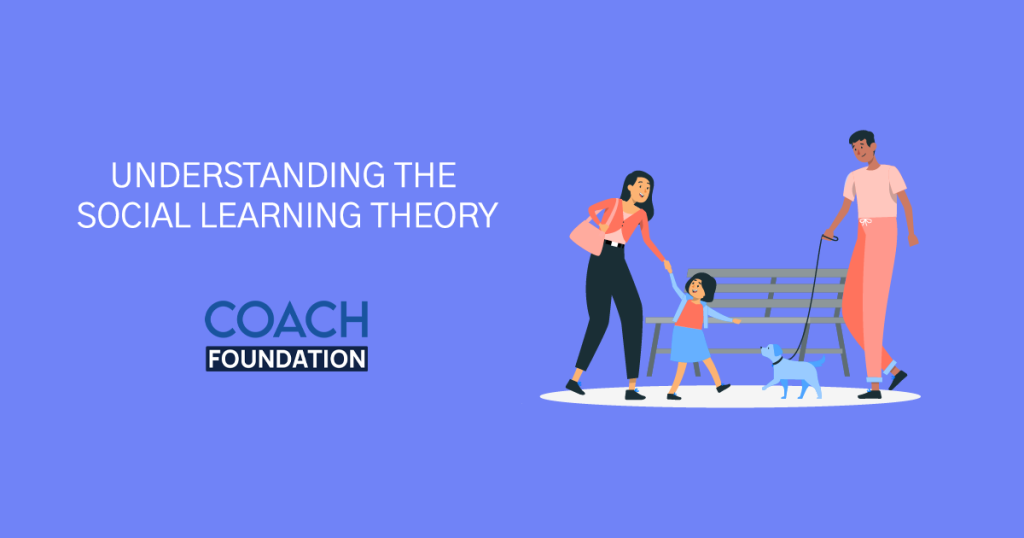Blog » Coaching Models and Techniques » Understanding The Social Learning Theory
Understanding The Social Learning Theory
Albert Bandura, a psychologist, developed the social learning theory to explain how people learn by imitating, copying, and modeling others. It emphasizes the importance of social and environmental factors in shaping behavior as well as the role of cognitive processes such as attention, retention, and motivation.

The theory suggests that individuals can learn new behaviors and attitudes by observing and imitating others, and that reinforcement and punishment can affect the likelihood of those behaviors being repeated in the future. Social learning theory has broad applications in fields such as education, psychology, and criminology. We will also dive into examples of how it can be applied to life coaching.
In this blog, we’ll explore:
What is the social learning theory
How does social learning theory work
Core Concepts of social learning theory
Application of social learning theory to life coaching
So, let’s get started!
What is the Social Learning Theory?
According to the Social Learning Theory, people learn by imitating and observing other people’s behaviors, and those behaviors’ rewards or punishments have an impact on that learning.
The Social Learning Theory, also known as Social Cognitive Theory, is a psychological theory that explains how people learn through observing others’ behaviors, attitudes, and outcomes. The theory suggests that people learn by observing and modeling the behaviors of others. This process of learning from others is called observational learning.
The social learning theory was proposed by Albert Bandura, a Canadian psychologist, in the 1960s. As per this theory, individuals can acquire new behaviors, attitudes, and values by watching and imitating others, particularly those they perceive as credible or influential. The theory emphasizes the role of social and environmental factors in shaping behavior, as well as cognitive processes such as attention, retention, and motivation.
The Social Learning Theory proposes that learning can occur through four main stages: attention, retention, reproduction, and motivation. First, individuals must pay attention to the behavior they are observing. Second, they must be able to retain the information in memory for later use.
Third, they must be able to reproduce the behavior they observed, either through direct imitation or by adapting it to their circumstances. Finally, they must be motivated to engage in the behavior, which can be influenced by factors such as reinforcement and punishment.
Check out this video to unravel more about the Social Learning Theory and Bandura’s experiments!
How does Social Learning Theory work?
Social Learning Theory proposes that people learn through observation, imitation, and modeling of others. This theory suggests that individuals can acquire new behaviors, attitudes, and values by watching and imitating others, particularly those they perceive as credible or influential. Here is an example of how the social learning theory works:
Let’s say a child sees their parents recycling at home. The child observes the parents sorting recyclables into different bins and taking them out to be collected on a designated day. The child pays attention to this behavior and retains the information in memory. Later, the child reproduces the behavior by sorting their own recyclables and reminding their parents to take them out on the designated day. The child is motivated to engage in the behavior because they have observed their parents receiving praise for their actions, which serves as reinforcement.
This example shows how the social learning theory can work in real-life situations. The child learned about recycling through observation of their parents’ behavior, and this learning was reinforced through positive feedback from their parents. By modeling the behavior they observed, the child adopted the practice of recycling as their own.
Overall, the social learning theory highlights the importance of social and environmental factors in shaping behavior. By understanding how people learn through observation and modeling, we can create more effective strategies for promoting positive behaviors and attitudes.
I went through this comprehensive article explaining the social learning theory and would suggest the readers go through it once as well!
Core Concepts of Social Learning Theory
The Social Learning Theory is based on the core concepts of observational learning, reinforcement and punishment, vicarious reinforcement and punishment, self-efficacy, and modeling. Observational learning involves learning by watching others, while reinforcement and punishment strengthen or weaken behavior.
Vicarious reinforcement and punishment occur when we learn from the experiences of others, and self-efficacy is a person’s belief in their ability to perform a particular behavior. Modeling is when a person imitates the behavior of another person.
Observational learning
Observational learning is the process of learning by observing others. People can learn new behaviors, attitudes, and skills by observing others perform them. It involves acquiring new behaviors or skills by watching and imitating others, without the need for direct reinforcement.
For example, a child may learn how to tie their shoes by watching their parent or teacher demonstrate the skill. The child observes the steps involved in tying shoes and then tries to reproduce them on their own. Through practice, the child can master the skill and tie their shoes independently.
Another example of observational learning is learning how to play an instrument. A beginner musician may watch a more experienced musician play a piece and then attempt to reproduce it themselves, without any direct instruction.
Check out this article explaining observational learning in detail!
Reinforcement and punishment
Reinforcement and punishment are two essential components of the Social Learning Theory. Reinforcement refers to the process of increasing the likelihood of a behavior by providing rewards such as praise, recognition, or tangible rewards. Punishment, on the other hand, refers to the process of decreasing the likelihood of a behavior by providing negative consequences such as scolding or taking away privileges.
There are two types of reinforcement: positive reinforcement and negative reinforcement.
Positive reinforcement: It involves adding a pleasant or desirable stimulus to the environment to increase the likelihood of a behavior being repeated. For example, giving a child candy for completing their homework on time is a positive reinforcement.
Negative reinforcement: It involves removing an unpleasant or aversive stimulus from the environment to increase the likelihood of a behavior being repeated. For example, a person may take aspirin to relieve a headache, which reinforces the behavior of taking aspirin when experiencing a headache.
There are also two types of punishment: positive punishment and negative punishment.
Positive punishment: It involves adding an unpleasant or aversive stimulus to the environment to decrease the likelihood of a behavior being repeated. For example, scolding a child for misbehaving is a positive punishment.
Negative punishment: It involves removing a pleasant or desirable stimulus from the environment to decrease the likelihood of a behavior being repeated. For example, taking away a child’s TV privileges for misbehaving is a negative punishment.
For understanding the difference between reinforcement and punishment, check out this video!
Vicarious reinforcement and punishment
Vicarious reinforcement and punishment are types of learning that occur through observing the consequences of other people’s behavior, rather than through direct experience. Vicarious reinforcement occurs when an individual observes someone else receiving a reward or positive consequence for their behavior, which increases the likelihood of the observer engaging in that behavior.
For example, a child may observe their friend getting praised by their teacher for sharing a toy, and this vicarious reinforcement may encourage the child to engage in sharing behaviors in the future. Alternatively, a child may observe a classmate being scolded by their teacher for talking out of turn, and this vicarious punishment may discourage the child from engaging in similar behavior.
Self-efficacy
Self-efficacy refers to a person’s belief in their ability to accomplish a task. According to the Social Learning Theory, people are more likely to engage in behaviors that they believe they can successfully perform.
A person who has a high level of self-efficacy may be more likely to take on new challenges and persist in the face of difficulties. For example, a student who believes in their ability to perform well on an exam is more likely to study hard and perform well, compared to a student with low self-efficacy.
Better understand the role of self-efficacy in social learning theory through this article!
Modeling
Modeling refers to the process of learning by imitating the behaviors of others. People may model the behaviors of others who they admire, respect, or believe to be successful. For example, the young athlete may model the behaviors of their favorite athlete to improve their performance.
Types of modeling in the self-learning theory:
- Live Modeling: The observer observes a real-life person performing a behavior or skill.
- Symbolic Modeling: The observer learns by observing someone perform a behavior or skill in a media representation, such as a video or a movie.
- Verbal Modeling: The observer learns through listening to verbal instructions, such as a teacher or coach explaining how to perform a task.
- Self-Modeling: The observer observes their own behavior and its outcomes in a video or the mirror to learn new behaviors or to improve existing ones.
Applying Social Learning Theory to life coaching
Social learning theory can be applied to life coaching in a variety of ways. As life coaches work with individuals to help them achieve their goals and make positive changes in their lives, they can use the principles of social learning theory to help their clients learn new behaviors and skills.
Firstly, coaches can use modeling to demonstrate desired behaviors and skills to their clients. By showing their clients how to behave in certain situations or how to perform a specific task, coaches can help their clients learn through observation and imitation.
Secondly, coaches can use positive reinforcement to encourage their clients to engage in desired behaviors. For example, a coach may provide praise or rewards for their client’s efforts and progress toward their goals, which can increase the likelihood of the client continuing to engage in those behaviors.
Thirdly, coaches can help their clients develop self-efficacy by building their confidence in their abilities to achieve their goals. Coaches can help their clients identify their strengths and successes, which can help increase their self-efficacy and motivate them to continue working towards their goals.
Finally, coaches can help their clients overcome barriers and obstacles by using cognitive restructuring and problem-solving techniques. By helping clients reframe negative thoughts and beliefs, coaches can help them approach challenges with a more positive and effective mindset.
Overall, applying social learning theory to life coaching can help coaches to facilitate positive changes in their clients’ lives by using evidence-based strategies for learning and behavior change.
Conclusion
The Social Learning Theory is a powerful tool for understanding how people learn and how it can be applied to various fields, including education, psychology, and life coaching. By understanding the core concepts of the Social Learning Theory, life coaches can help their clients achieve their goals by providing them with the right tools, motivation, and support.
Social Learning Theory suggests that people learn from observing others and imitating their behaviors. It emphasizes the importance of cognitive processes and social contexts in shaping behavior.
I’m looking forward to hearing your thoughts on this engaging blog post, and I would be grateful if you could share any further ideas or perspectives you have in the comments section.
Frequently Asked Questions (FAQs)
What is the concept of the Social Learning Theory?
The Social Learning Theory is a psychological theory that explains how people learn through observing others’ behaviors, attitudes, and outcomes. According to this theory, individuals can learn new behaviors and skills by observing the behaviors and outcomes of others, and by interacting with others through social reinforcement and punishment.
What are a few examples of Social Learning Theory?
Examples of Social Learning Theory include learning how to tie your shoes by observing your parents or siblings, learning a new skill by watching a tutorial video or learning social norms by observing the behaviors of others.
Who founded Social Learning Theory?
Social Learning Theory was first proposed by the American psychologist Albert Bandura in the mid-20th century, who is considered to be one of the most influential psychologists of all time.

ABOUT SAI BLACKBYRN
I’m Sai Blackbyrn, better known as “The Coach’s Mentor.” I help Coaches like you establish their business online. My system is simple: close more clients at higher fees. You can take advantage of technology, and use it as a catalyst to grow your coaching business in a matter of weeks; not months, not years. It’s easier than you think.
AS SEEN ON





